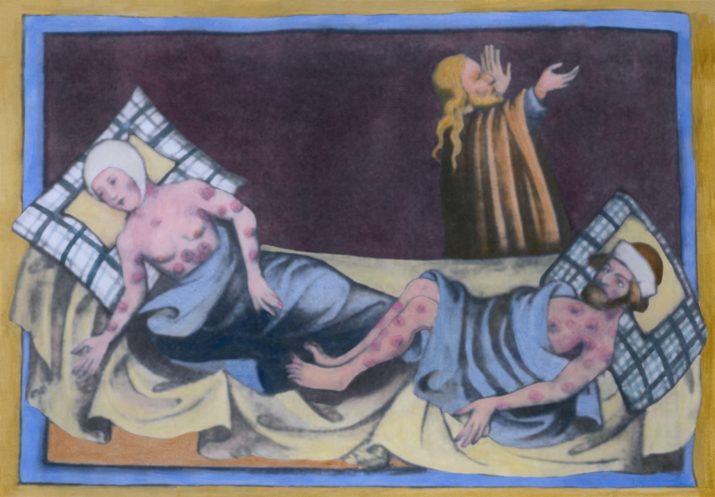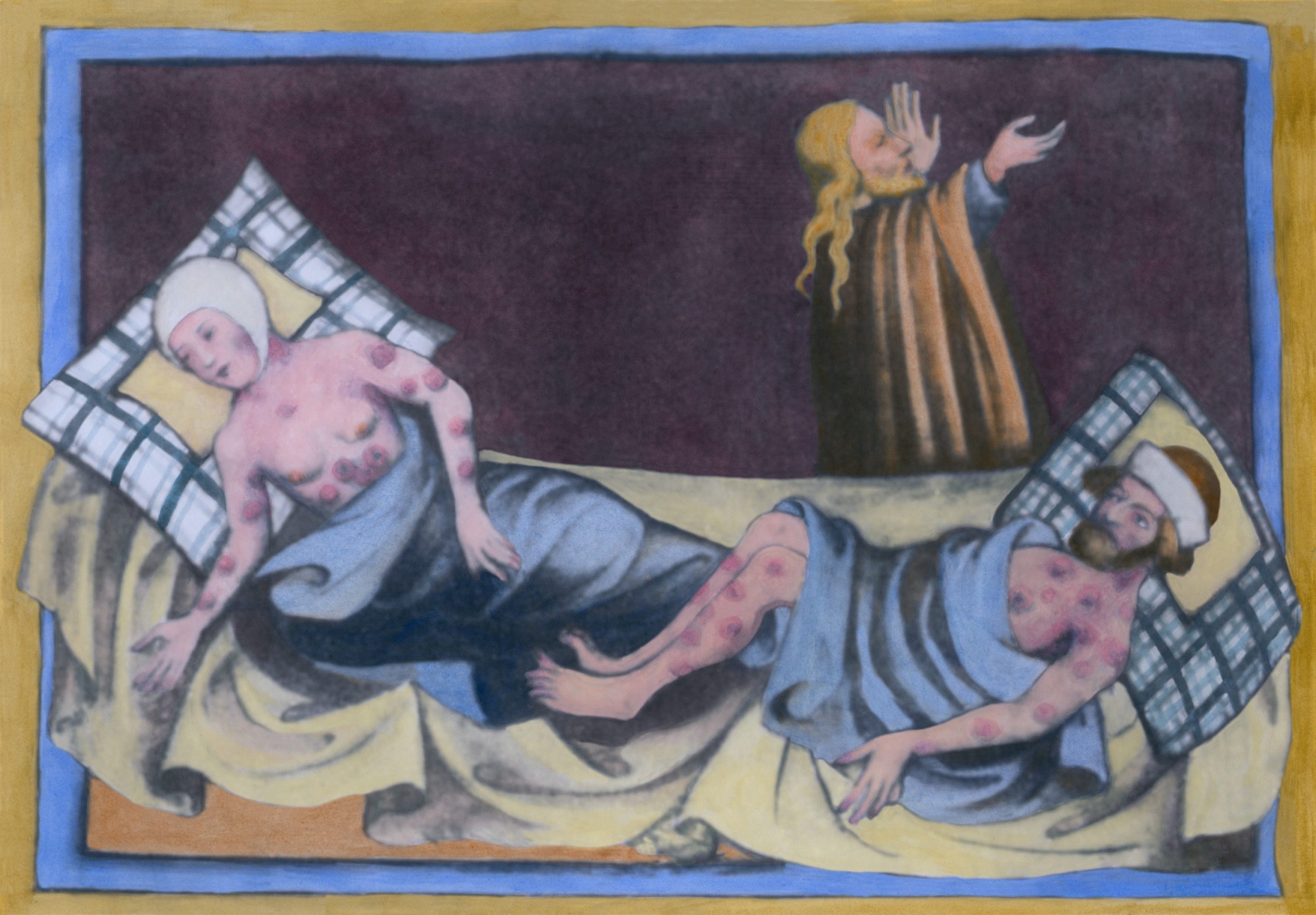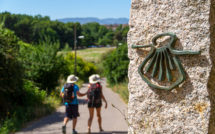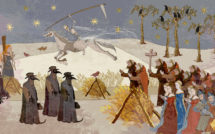

This is part of our Campus roundtable on Teaching Medieval in Modern Plague Times.
“Isn’t it ironic,” asked a student in my Spring 2020 class on the history of western medicine, “that we’re studying this now?” Other students chimed in with agreement or additional observations. In March of 2020, studying the history of medicine and the vulnerability of human populations to illness seemed, to them, uncomfortably apt, perhaps particularly because we had recently studied the mismanagement of pandemic in Vietnam under French colonial rule.[1] Attempting to remain optimistic, I said that I hoped the questions we’d been engaging with all semester would help them as we all tried to process our new reality, and to cope with its challenges. (I also defined the word “ironic.”) Mere hours before I stood in front of that classroom, ready to discuss herbal medicine, faculty had been informed by administration that that day would be the last of in-person instruction.
The spring transition was a rough one. But in the history of medicine course, at least, its subject matter made the adjustment of assignments easier, and the sudden reminder of how incomplete our modern knowledge is, and how imperfect modern policy responses can be, rendered students more empathetic than usual in discussing medieval approaches to defining medicine and providing hospital care. Instead of the planned research presentations that students would have given during our exam week, I had them all turn in reflections on their experiences of living in a time of plague. These could be excerpts from journals, which I had encouraged them to keep, or purpose-written pieces. The topics they wrote on were varied: from complaints about dining hall food, to comparison of medieval and modern government responses, to reflections on the experiences of caring for elderly relatives or younger siblings. Each submission earned full credit automatically; and my responses to these offered a welcome opportunity to communicate directly with students, to share sympathies and encouragement, as well as responding to their engagement with the course. In other classes, I replaced student presentations on their independent research with reflections on their experiences in the course. These were instructive for me, and also provided an easy way for me to boost student grades in a time of stress and uncertainty.
Between the spring and fall semesters of 2020, I moved between states and institutions… and, just for good measure, learning management systems. So, my learning curve for teaching in the time of COVID-19 has been complicated by a few others. At my new institution, except in cases of faculty successfully requesting to teach online, whether a class is taught face-to-face or in hybrid format depends on enrollment. What this has meant for me, in effect, is designing an online and an in-person version of my premodern global survey course to run simultaneously. My hybrid version of the course on medieval European history relies even more heavily than usual on discussion and analysis of primary sources, conducted both in the classroom and on the LMS discussion boards for the class. Structurally, I like the extra support this provides for students: it means that in every class session, I can use the questions I’ve already published on the discussion boards as our starting points. I’ve also done this in the introductory survey. Though few students have interacted with these posts, I at least know that they provide additional guidance for students often intimidated by premodern primary sources.
Because I was worried about the potential loss of community, especially if we were to shift to a wholly online format, I’ve had students in Medieval Europe (an upper-level course) post their weekly responses so that they are visible to classmates. These responses consist of answering two of the course’s framing questions, and posing two analytical questions of their own; such low-stakes assignments function as a reading check-in, and a way for me to assess how students are gaining proficiency in reading medieval sources. Having them all open to the class as a whole, I hoped, would help enrich community and increase accountability; the loss of both of these things had been much lamented by students in the spring semester. Approximately halfway through the fall semester, dealing with an unfamiliar student body in extraordinary circumstances, I’m not sure how I’d rate the success of this enterprise. But I like the principle of it, and am thinking about how I might revise or reframe it for next semester, perhaps by reducing the required length of the original writing, and requiring a response to a classmate as part of the weekly assignment. I’ve used similar weekly responses in courses on modern history at the introductory and intermediate level; while the framing questions for the course need to be tailored, the basic assignment structure is easily transferable.
In this plague-haunted semester, I’m particularly happy about my decision to revise the assignment structures of my classes to include unit reflections, graded on completion. This has certainly helped reduce stress for me, and I hope for students, by building automatic As—if the work is completed, sometimes a big if—into their overall course grade. Because students are often particularly intimidated by the perceived strangeness of the medieval, I’ve also built more ungraded components, and more scaffolding, into the independent research projects that form the summative assessment of what students have learned about medieval European history and how to study it. I’m very pleased with the results. The component I added was an ungraded topic submission, due approximately two weeks before the submission of abstract and annotated bibliography. This allowed me to offer feedback on the scope and feasibility of projects, and help students who were struggling to find appropriate or adequate resources. This year, I made the abstract and annotated bibliography ungraded, and I may persist in that. Some students, true, are doing A-level work that goes formally unrewarded (though, of course, encouraged in my written comments.) But this way, the students who have not turned anything in are not dealing with the impact of an F—and not only an F, but a zero—on this portion of the course grade in addition to whatever combination of factors resulted in their failure to submit work in the first place. I assign versions of this project in many intermediate and upper-level history courses, and find that giving students the options of pitching a TV show, writing a curriculum unit, or designing an art exhibit yields good conversations about process, and good results, while still allowing them to use the research paper format with which many of them are most comfortable.
Teaching medieval history with online tools has been an educational experience. Uploading lectures and transcripts for students has, I think, improved the organization of several lectures that had previously survived several iterations with only minor tweaking. It’s also taught me which days of the medieval survey I ad-lib the most in (my notes on the Carolingian Empire and mendicant movements are now much fuller.) It’s expanded my use of online resources: for instance, a StoryMap on Henry V’s Agincourt campaign, and a recorded lecture on Sufi mystics in medieval Egypt.[2]The Middle Ages for Educators, a resource-sharing site created in response to the pandemic, helped me to find both of these.[3] I’ve used Perusall for the first time, uploading textual primary sources and links to medieval music for students to annotate. I’m also thinking about ways in which I might continue to expand my use of online opportunities next semester, for instance, through a remote guest lecture swap with a colleague in the spring. Taking the medieval online has been challenging, but it has also helped me to expand community and collaboration beyond the classroom.
Lucy Barnhouse is an Assistant Professor at Arkansas State University. Her forthcoming monograph, Houses of God, Places for the Sick, examines hospitals as religious institutions in late medieval cities. She teaches a wide variety of courses in premodern history, and is a founding member of the Footnoting History podcast.
References:
[1] Michael G. Vann and Liz Clarke, The Great Hanoi Rat Hunt: Empire, Disease, and Modernity in French Colonial Vietnam (Oxford: Oxford University Press, 2018.)
[2] Ioannis-Rafail Chatzis, “The Road to Agincourt,” https://www.arcgis.com/apps/Cascade/index.html?appid=2a5058d182fc47dc833e1b803cd2bf04, last accessed October 25, 2020; Nathan Hofer, “The Popularization of Islamic Mysticism in Medieval Egypt,” https://www.loc.gov/item/webcast-6878, last accessed October 25, 2020.
[3] Middle Ages for Educators, http://middleagesforeducators.com/, last accessed October 25, 2020.
Photo: Man and women with the plague of boils, Medieval painting from a German language Bible of 1411 from Toggenburg Switzerland | Shutterstock
Published on December 8, 2020.




